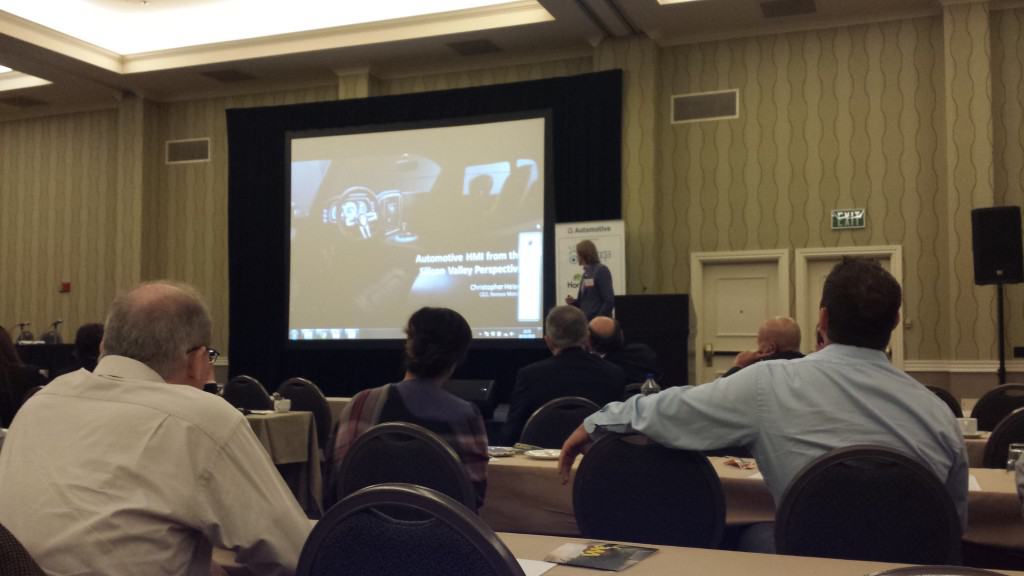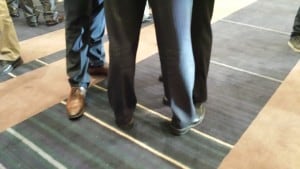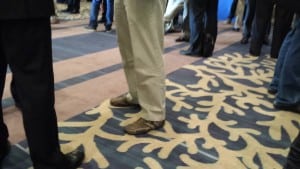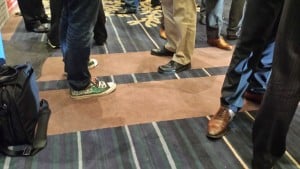 Telematics West Coast explored pertinent issues as well as what will be in the future of connected cars. This the second report of what was discussed during the show.
Telematics West Coast explored pertinent issues as well as what will be in the future of connected cars. This the second report of what was discussed during the show.
Your Car as Personal Assistant
Pavan Mathew, senior director, Automotive Content Service Strategy, Nuance showed future scenarios of voice interaction with cars in which the vehicle anticipates the needs of the driver or passenger through natural language understanding. The car acts an intelligent assistant. The car understands what content driver is looking for. Say the driver asks “What team won the game?” The personal assistant asks “What team?” Then after the question is answered automatically knows the team scores to look for. The personal assistant knows work time, route, calendar and can change ETA, putting together multiple areas of content. The system becomes an interactive conversational dialog with driver or passengers. It can play music, stop music to send a text then go back to playing music.
The OTA Way
Walter Buga, CEO, Arynga stated that Over-the-Air(OTA) updates should be robust, secure, and reliable. OTA updates ensure the reliability of vehicle software/firmware for the lifecycle of the vehicle. In fact, OTA could create new business models such as for connected car mobile devices, opportunities for car sharing, tracking of trucks or pay-per-use. OTA can also be used to fix software for recalls. OTA updates offers the potential for aftermarket sales, shorter life cycles, tracking of ECUs, reduced warranty costs, improved dealer profits, enhanced satisfaction, brand loyalty, revenue, ability to comply with regulations and manage security.
What Dealers Automakers Say About OTA
Albert Gallegos, director of International Affairs, NADA moderated a panel discussing how dealers will deal with Over-the-Air (OTA) software updates.
“Customers don’t care about OTA, all they care is if it works”, said Jason Schulz, business development and partnerships nanager, Toyota, however, “We don’t want anyone jailbreaking a car.”
Rich Shannon, Telematics Division manager, Honda North America, noted that the ultimate liability for software updates is with the OEM. Honda may offer OTA updates in very small steps to limit to small systems updates, treat each within a sandbox firewall. OTA updates may be an appealing feature for the 2020 Accord or later.
However, before OTA updates become common place consumers need to be informed about what they are and how they work noted a panelist.
Innovation Inspiration from Silicon Valley
Christopher Heiser, CEO, Renovo suggested that automakers look at developments outside of the car space for what ideas are popular. Cars are still trying to catch up with smartphone with features such as OTA updates and voice. He believes that haptic feedback that is popular in the Apple Watch and gesture control are not there yet outside, to be featured inside cars. However, 3D dynamic displays similar to what has been deployed in games for many years can be easily adapted to the control panels and infotainment systems of cars. He says that Tesla offers inspiration to other automakers to get their imaginations expanded.
How to Smartly Integrate Smartphones
Robert Gee, Head of Product Management, Software and Connected Solutions, Continental, lead a discussion about open software and smartphone integration.
Rudolf Streif, System Architect Jaguar Land Rover said that user experience matters as well as connectivity to devices. Jaguar opened its Innovation Incubator Project” project in Portland, Oregon, to encourage, developers to develop for their vehicles. The company uses parts of the GENIVI open platform, as well as develops their own software. It shares its findings with other automakers.
Frankie James, managing director, GM ASTVO, General Motors said that people want to bring Apple and Google/smartphones into their cars. More smartphones are sold than cars every year therefore it is easier to adapt the cars to the smartphone user experience. GM is the first mainstream automaker to offer Android Auto and Apple CarPlay across most of its models.
Alan Ewing, President, CCC MirrorLink, said “The Prohibition of smartphones has ever worked, We have to find way to do it the right way. It is safety critical don’t have room for mistakes.” He also stated that standardization of systems helps make it easier.
The Future of Streaming
Greg Basich, senior nnalyst , Global Automotive Practice, Strategy Analytics lead a discussion of what can be streamed into cars and what will be available in the future.
Cason Grover, senior group manager, Cross Carline Planning, Hyundai said, “The question of OTA updates is not a question of how but when.”
Hyundai wants to embrace Android Auto, because it is strong brand for the younger generation. If Android Auto or Apple CarPlay control the infotainment, the automakers can concentrate on the car design itself. It will not be until there is full autonomous driving until video will be streamed into the car and then driver could even use bar finder apps.
Steffen Neumann, Portfolio Manager, Mercedes-Benz R&D North America reported that the company now has a center in Silicon Valley to speed up development with start-ups and engineers. Mercedes-Benz vehicles have embedded browsers in the head units which makes it easier to update apps.
When there is freedom from driving and cars are autonomous, such as the Luxury in Motion, concept car shown at CES with large screens then there can be opportunities for video conferencing, email or other tasks.
Jason Stinson, CTO, Renovo Motors envisions a time when apps will not be “fluffy” such as navigation or music but use the massive numbers of sensors in cars to change the way the car drives. For instance, an app that adapts the battery usage of an electric car so that it can make it back home without stopping for a charge. As for what kind of fuel will be used in the car of the future, Stinson is not sure “It will have an electric drive train, but we don’t know if the power will come from hydrogen, electric or unicorn farts.”
“It was great to see common and different viewpoints between the consumer electronics and auto industries, on so many topics, so clearly on display at Telematics West Coast. Both have much to learn from one another. It will be interesting to see the relationship continue to evolve,” said Strategy Analytics’ analyst Derek Vita.
The day ended with a cocktail reception where we were able discuss pertinent issues with industry insiders such as:
Why do carmakers keep putting the cup holder right next to the ports/plugs? I have rented, tested or owned cars where the cup holder is right below the USB Aux and 12 Volt ports. All it takes is bump in the road or jump from a puppy and the liquid spills right into the electrical ports which can be dangerous. Strategy Analytics’s UX expert Derek Vita promised to look at where the cup holder is in relationship to the ports when providing suggestions to OEMs for infotainment designs.
When will an electric car manufacturer offer better newer batteries for older models? I discussed the issue with a major non-American automaker exec who said it could be possible to offer improved longer distance per charge batteries for an older model EVs which could ground breaking.
Car review websites should do dependent smog checks – Strategy Analytics analysts Greg Basich, and Derek Vita agreed with Lynn Walford that a major car review website should perform emissions tests on new vehicles using a method that can’t be fooled. Lynn Walford has the contacts to perform the tests in a way that can not be duped by software like that used by VW in the diesel scandal. She said she has not had the time to contact publishers with the idea.
UBI Insurance isn’t right for everyone – Some UBI insurance companies such as MetroMile do not offer medical payments. In California, where many accidents often occur with uninsured motorists and heath care is difficult, medical payments ensure that people injured in accidents are provided with good health care One UBI insurance device provider, attending Telematics West Coast is looking into medical payment coverage.
What’s up with Silicon Valley vs Automakers? A new consumer researcher at the event noted there seemed to be chasm between what Silicon Valley wants/produces and what the automakers do. The issue is best illustrated with the photographs below of the shoes at the event. Guess which shoe wearer was from Silicon Valley? If you think you know who it is please post your idea in the comments below.
How green are unicorn farts? Jason Stinson confirmed that there are absolutely no green house gases produced by unicorn farts. I offered the suggestion that Renovo feed the unicorn bean burritos and tacos for more gas. He said that unicorns don’t eat tacos. I suggested tofu might be a better alternative fuel although some believe that wheat grass juice is the best green fuel for unicorns.


